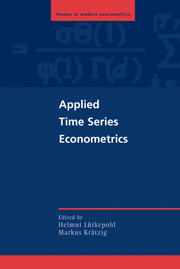Book contents
- Frontmatter
- Contents
- Preface
- Notation and Abbreviations
- List of Contributors
- 1 Initial Tasks and Overview
- 2 Univariate Time Series Analysis
- 3 Vector Autoregressive and Vector Error Correction Models
- 4 Structural Vector Autoregressive Modeling and Impulse Responses
- 5 Conditional Heteroskedasticity
- 6 Smooth Transition Regression Modeling
- 7 Nonparametric Time Series Modeling
- 8 The Software JMu⌉Ti
- References
- Index
4 - Structural Vector Autoregressive Modeling and Impulse Responses
Published online by Cambridge University Press: 23 November 2009
- Frontmatter
- Contents
- Preface
- Notation and Abbreviations
- List of Contributors
- 1 Initial Tasks and Overview
- 2 Univariate Time Series Analysis
- 3 Vector Autoregressive and Vector Error Correction Models
- 4 Structural Vector Autoregressive Modeling and Impulse Responses
- 5 Conditional Heteroskedasticity
- 6 Smooth Transition Regression Modeling
- 7 Nonparametric Time Series Modeling
- 8 The Software JMu⌉Ti
- References
- Index
Summary
Introduction
In the previous chapter we have seen how a model for the DGP of a set of economic time series variables can be constructed. When such a model is available, it can be used for analyzing the dynamic interactions between the variables. This kind of analysis is usually done by tracing the effect of an impulse in one of the variables through the system. In other words, an impulse response analysis is performed. Although this is technically straightforward, some problems related to impulse response analysis exist that have been the subject of considerable discussion in the literature.
As argued forcefully by Cooley & LeRoy (1985), vector autoregressions have the status of “reduced form” models and therefore are merely vehicles to summarize the dynamic properties of the data. Without reference to a specific economic structure, such reduced-formVAR models are difficult to understand. For example, it is often difficult to draw any conclusion from the large number of coefficient estimates in a VAR system. As long as such parameters are not related to “deep” structural parameters characterizing preferences, technologies, and optimization behavior, the parameters do not have an economic meaning and are subject to the so-called Lucas critique.
Sims (1981, 1986), Bernanke (1986), and Shapiro & Watson (1988) put forward a new class of econometric models that is now known as structural vector autoregression (SVAR) or identified VAR. Instead of identifying the (autoregressive) coefficients, identification focuses on the errors of the system, which are interpreted as (linear combinations of) exogenous shocks. In the early applications of Sargent (1978) and Sims (1980), the innovations of the VAR were orthogonalized using a Choleski decomposition of the covariance matrix.
- Type
- Chapter
- Information
- Applied Time Series Econometrics , pp. 159 - 196Publisher: Cambridge University PressPrint publication year: 2004
- 79
- Cited by



